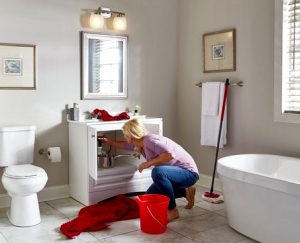Bathroom floor tile is available in a surprising number of materials. Ceramic, porcelain, and vinyl tiles are what come to mind first, and for good reason: They’re perhaps the most practical options. But there are many options available, from stone to cork.
Vinyl Tiles
Vinyl is the most popular bathroom flooring material, because of its low cost and a high degree of practicality. It is well-suited for every bathroom in the house, from the master bath to the powder room. Hands down, it beats other popular choices for safety, comfort, and durability. Almost as important, vinyl tiles have come a long way in aesthetic appeal and ease of installation. The material is self-adhering and can be cut with a utility knife.
Ceramic and Porcelain Tiles
Like vinyl, ceramics score high with regard to maintenance, too, but they are not nearly as comfortable to the barefoot. Ceramics are not as easy to install as vinyl, though it is a job the adventurous do-it-yourselfer can tackle. When protected with a high-grade glaze, ceramic will resist wear and scratches. Porcelain tiles are harder than clay-based tiles and may have through-body color, an advantage if chipping occurs.
Glass Tiles
The aesthetic appeal of a glass floor tile is twofold: Covering part of the floor in a thin layer of glass creates the illusion of depth and, if tinted, a lovely stained-glass effect. Installed properly, this type of tile holds up well—just be sure to select a textured glass to prevent slips. Small glass tiles with lots of grout joints are also slip-resistant.
Stone Tiles
Stone tiles were once confined to the foyer. In the past decade, however, they have become popular in other rooms as well, bathroom included. Made from limestone, marble, granite, and slate, stone tiles are available in colors that range from creams to blues, reds, greens, and golds. Stone requires more maintenance than ceramic tile; regular cleaning and sealing are recommended.
Plastic Laminate Tiles
Plastic laminate tiles are also a good choice, especially if you’re remodeling. Similar to the laminate material that covered kitchen countertops for a generation or two, the tiles don’t significantly raise the height of the existing floor, which makes it easier to plan transitions from room to room. While durable and easy to keep clean, laminate falls short when it comes to moisture. Standing water can infiltrate the fiberboard core, causing the material to expand and buckle, which makes it one tile that might work better in a half-bath than a full bath.
Linoleum Floor Tiles
Linoleum is made of linseed oil, cork powder, wood flour, ground limestone, and pigments. It is at home in contemporary or retro settings and well-suited to the bathroom. It’s touted as naturally inhibiting the growth of microorganisms and being able to repel dust and dirt, all while retaining its color.
Cork Tiles
Cork flooring is warm to the touch and very easy on the feet, and the tiles come tinted in a variety of colors. Glue-down installation is not difficult, but expect to apply multiple coats of polyurethane to seal the flooring and prevent moisture from reaching the subfloor, even if you purchase finished tiles.



